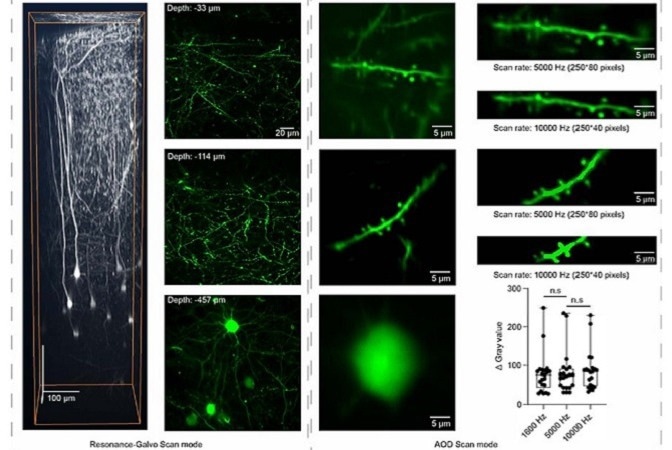The design of ground-breaking laser scanning opens high-accuracy observations at up to 10,000 frames per second, thereby making the microscope a strong recording tool.
 By combining two laser scanning modes, researchers have developed a versatile two-photon microscopy system that can be used to observe extremely fast biological processes at high frame rates and spatial resolution. Image Credit: Li et al., doi 10.1117/1.NPh.10.2.025006
By combining two laser scanning modes, researchers have developed a versatile two-photon microscopy system that can be used to observe extremely fast biological processes at high frame rates and spatial resolution. Image Credit: Li et al., doi 10.1117/1.NPh.10.2.025006
The field of biology has been revolutionized by two-photon microscopy (TPM), allowing scientists to note complicated biological processes in living tissues at high resolution. Contrary to conventional fluorescence microscopy methods, TPM utilizes low-energy photons to stimulate fluorescent molecules for observation.
This, in return, makes it feasible to enter the tissue much more strongly and guarantees that the fluorescent molecules, or fluorophores, are not subjected to permanent damage by the excitation laser.
But few biological processes are too rapid to be recorded, even with sophisticated TPMs. One of the design parameters that restrict the performance of a TPM is the line scanning frequency, quantified as frames per second (FPS). This relates to the rate at which the target sample could be swept throughout by the excitation laser together in one direction (for example, in a horizontal sweep).
Also, slow scanning frequency affects the entire FPS of the system, as it identifies how rapidly the laser could be swept across the other direction, that is, in a vertical sweep. Collectively, these make a trade-off between the temporal resolution of the microscope and also the size of the observation frame.
Working around this issue, an international group of scientists from China and Germany recently has come up with a strong TPM setup with a uniquely high line scanning frequency.
As per their report in the journal Neurophotonics, this microscopy system was developed for imaging rapid biological processes at a high temporal as well as spatial resolution.
One of the main factors that differentiate the suggested TPM from the traditional ones is the use of acousto-optic deflectors (AODs) to regulate the scanning of the excitation laser. An AOD is a unique kind of crystal whose refractive index can be accurately regulated by acoustic waves.
This, in return, enables one to redirect a laser beam through it as preferred. More significantly, AODs allow a quicker laser-steering compared to that achieved with the galvanometers utilized in traditional TPMs.
Therefore, the team developed a custom AOD with a remarkably high acoustic velocity with the help of a tellurium dioxide (TeO2) crystal, thereby helping to achieve a high line scanning frequency.
With this AOD, the laser has the potential to scan a line in the frame within a mere 2.5 μs, equivalent to an utmost line scanning frequency of 400 kHz. In the same way, the team made use of an AOD to obtain a reasonably slow scanning frequency in the other direction.
To enhance the adaptability of their microscope even more, the group added the option of shifting to a galvanometer-based laser scanning mechanism when essential. This enabled the scanning of large regions of the sample at a tolerable speed and resolution, thereby making it simpler to spot small areas of interest before switching to AOD scanning.
Various proof-of-concept experiments were performed by the team with the newly designed TPM. Cranial windows on genetically engineered mice were installed and utilized to note the activity and morphology of neurons as well as the movement of single red blood cells (RBCs).
A frame rate of up to 10,000 FPS was obtained by the system using a suitable frame size and AOD configuration. This was enough to accurately quantify the velocity at which calcium propagates in neuronal dendrites as well as to envision the trajectory of separate RBCs within blood vessels.
The new system for AOD-based scanning microscopy represents a substantial improvement in imaging speed and performance, as demonstrated in its application for calcium signal propagation and blood flow measurements in the brain in vivo.
Dr. Na Ji, Associate Editor of Neurophotonics and Luis Alvarez Memorial Chair in Experimental Physics, University of California Berkeley
In the future, the new proof-of-concept TPM design will make it feasible to capture quick biological processes and could considerably enhance their understanding of them.
Journal Reference:
Li, R., et al. (2023) Ten-kilohertz two-photon microscopy imaging of single-cell dendritic activity and hemodynamics in vivo. Neurophotonics. doi.org/10.1117/1.NPh.10.2.025006.